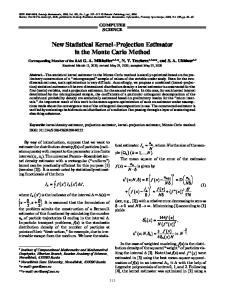Contributions to the adaptive Monte Carlo method
- PDF / 930,940 Bytes
- 10 Pages / 595.276 x 790.866 pts Page_size
- 118 Downloads / 392 Views
(2020) 42:462
TECHNICAL PAPER
Contributions to the adaptive Monte Carlo method José Eduardo Silveira Leal1 · Joyce Antunes da Silva1 · Rosenda Valdés Arencibia1 Received: 2 March 2020 / Accepted: 3 August 2020 © The Brazilian Society of Mechanical Sciences and Engineering 2020
Abstract The GUM Supplement 1 presented the adaptive Monte Carlo (AMC) method. A basic implementation of an AMC procedure involves carrying out an increasing number of Monte Carlo trials until four parameters have stabilized in a statistical sense. Although the AMC method has been successfully used for uncertainty evaluations, the amount of stored data was seen as significant, and even after achieving stability, it can be lost with the increase in the number of trials. To overcome these problems, two modifications to the AMC method were proposed, implemented and validated. The first is related to data storage, while the second consists of applying an alternative criterion to assess convergence. After modifications, the AMC was named the modified adaptive Monte Carlo (MAMC) method and was applied when estimating the uncertainty of measurements carried out with a micrometer. The MAMC effectiveness was validated through the comparison of the uncertainty values and those from the application of the GUM and AMC methods. Under the evaluated experimental conditions, the MAMC showed greater repeatability when compared to AMC, regarding the number of trials to be carried out. This factor contributes toward the higher reliability of this method. The amount of data to be stored and manipulated through the application of the MAMC method was decreased significantly. This fact may increase the adoption of the AMC method. Keywords Measurement uncertainty · GUM · Adaptive Monte Carlo method
1 Introduction The ‘Guide to the Expression of Uncertainty in Measurement’ (GUM) [1] provides concepts, recommendations and a procedure for the assessment of uncertainty. After the GUM publication, an increasing interest has arisen in evaluating the measurement uncertainty. This interest is motivated on the fact that many important decisions are based on measurement results, for example, to assess product conformity [2, 3], to check a material in relation to its specification limits [3] and to make therapeutic decisions. In such cases, it is essential to provide some indication of the result quality, and Technical Editor: José Roberto de França Arruda. * José Eduardo Silveira Leal [email protected] Joyce Antunes da Silva [email protected] Rosenda Valdés Arencibia [email protected] 1
Federal University of Uberlândia, 2121, João Naves de Ávila Avenue, Campus Santa Mônica, Uberlândia, MG 38400‑902, Brazil
for this purpose, measurement uncertainty is the metrological parameter used. According to [4], measurement uncertainty is one of the most important concepts in geometrical product specification. The study in Weckenmann et al. [5] showed how expanded uncertainty associated with the measurement result affects the limit values that define dimensional
Data Loading...











